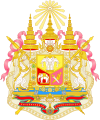Godło Tajlandii
 | |
| Informacje | |
| Wprowadzono | 1911 |
|---|---|
Godło Tajlandii reprezentowane jest przez mitycznego ptaka Garudę - jedno z bóstw w hinduizmie i buddyzmie, wierzchowca (vahanam) boga Wisznu.
Przedstawiony jest jako czerwony orzeł z ludzkim tułowiem i rękami, z których wyrastają pióra. W wielu miejscach ma różnorakie insygnia. Z czerwienią w wielu kulturach tej części świata związane są pozytywne konotacje. Dla Tajów jest to symbol wolności i nadziei na lepsze jutro.
Historyczne wersje godła
Symbol dynastii Czakri, założonej w 1782 przez króla Ramę I.
Godło Syjamu w latach 1873 - 1910, inspirowane herbami europejskimi.
Zobacz też
Media użyte na tej stronie
Autor: Ta ^specifik^ z W3C grafika wektorowa została stworzona za pomocą Inkscape., Licencja: CC BY-SA 3.0
Emblem of the Royal House of Chakri, the ruling Dynasty of Thailand (formerly Siam), founded in 1782. The Emblem depicts a 'Chakra' (disc) and a 'Trisula' (trident) intertwined. Both of these objects are weapons of Vishnu (of which the Kings of Siam believe themselves to be 'Avatars'). The symbols also directly relate to King Rama I's pre-coronation title of "Chao Phraya Chakri", which in itself is a combination of the word 'Chak' and 'Tri', thus denoting the two weapons.
Autor: Ta ^specifik^ z W3C grafika wektorowa została stworzona za pomocą Inkscape., Licencja: CC BY-SA 3.0
Emblem of the Royal House of Chakri, the ruling Dynasty of Thailand (formerly Siam), founded in 1782. The Emblem depicts a 'Chakra' (disc) and a 'Trisula' (trident) intertwined. Both of these objects are weapons of Vishunu (of which the Kings of Siam believe themselves to be 'Avatars'). The symbols also directly relates to King Rama I's pre coronation title of "Chao Phraya Chakri", which in itself is a combination of the word 'Chak' and 'Tri', thus denoting the two weapons.
Autor: Sodacan, Licencja: CC BY-SA 3.0
Royal Coat of Arms of the Kingdom of Siam 1873 to 1910. Description from Emblem of Thailand.
- Shield depicting the three-headed elephant (Erawan) of Siam, the White Elephant (Lan Xang) of Laos and the Krises of Malaya.
- Crowned by the Great Crown of Victory (rays of light from behind), Behind the shield are the crossed Sword of Victory (left), Royal Staff (right), Royal Fan (right) and Flywisk (left). The shield is surrounded on two sides by two seven-tiered Royal Umbrellas. On the compartments are two Royal Slippers. All, composing the six Royal Regalia of Siam.
- the Mantle is the cloak (with pink ribbons) of the Order of the Chula Chom Klao, the order around the shield is the Order of the Nine Gems with Chula Chomklao chain and pendant (with a portrait of King Rama V on it).
- Motto on green and red ribbon reads: "สพฺเพสํ สงฺฆภูตานํ สามคฺคี วุฑฺฒิ สาธิกา" (Pali written in Thai alphabet) ("Sabbesam Sanghabhutānam Sāmaggī Vuḍḍhi Sādhiga") or "Unity brings happiness".
- Supported by a Kojasiha; a lion with elephant trunk (dexter), and a Rajasiha; a lion (sinister), representing Kalahom and Mahathai, respectively.
National Emblem of Thailand, depicting a dancing Garuda with outstretched wings. The Garuda symbolizes the government and people of Thailand, as Lord Vishnu symbolizes King of Thailand.







